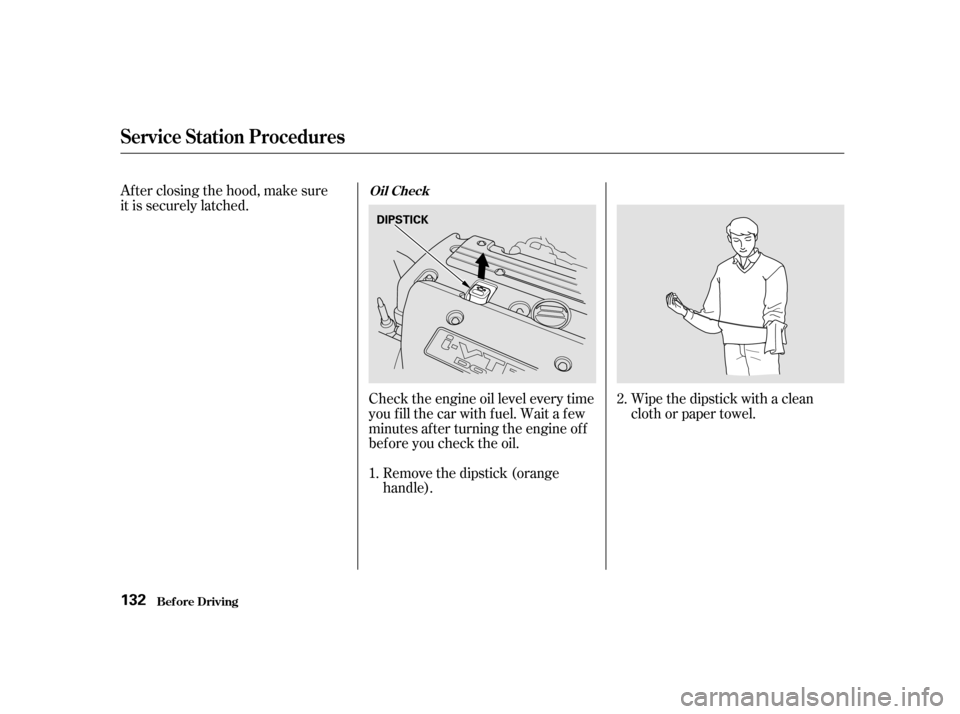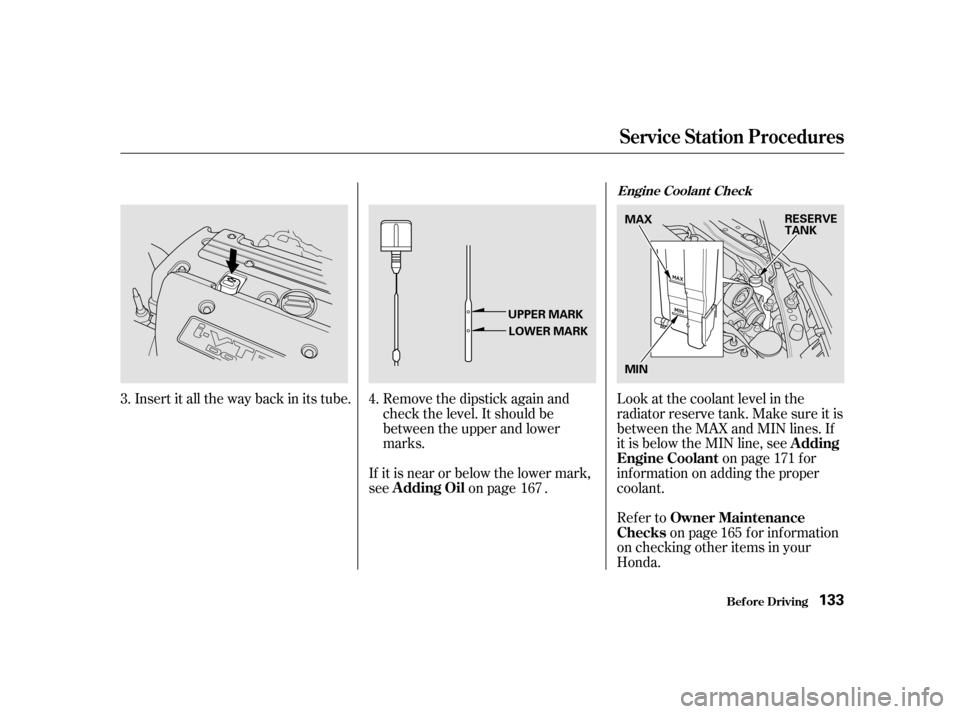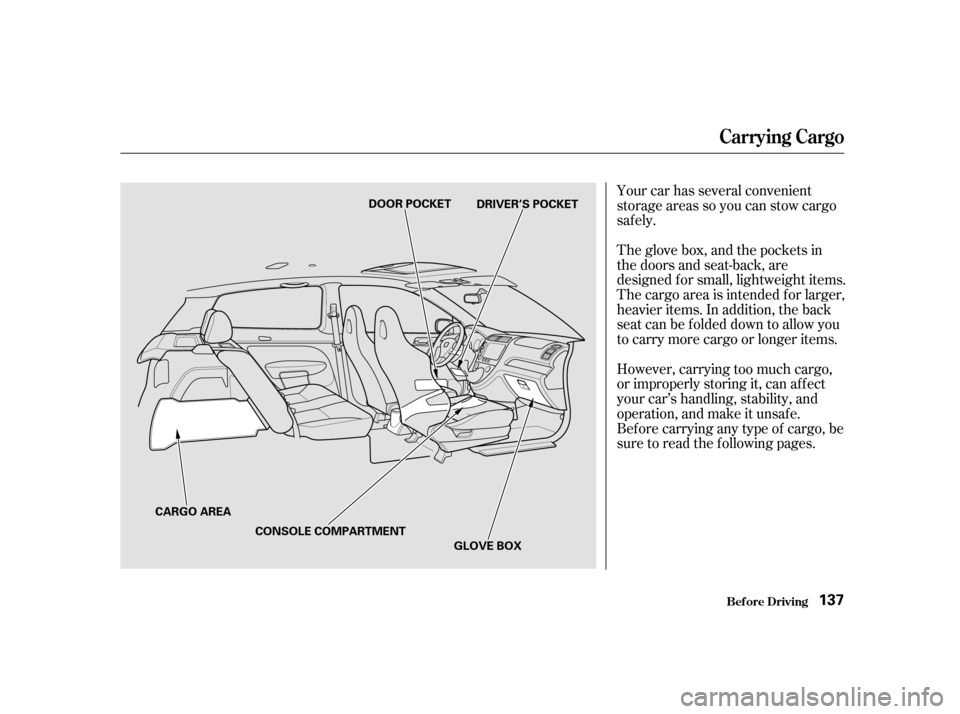HONDA CIVIC HATCHBACK 2003 7.G Owners Manual
Manufacturer: HONDA, Model Year: 2003, Model line: CIVIC HATCHBACK, Model: HONDA CIVIC HATCHBACK 2003 7.GPages: 275, PDF Size: 6.75 MB
Page 131 of 275

Wipe the dipstick with a clean
cloth or paper towel.
Check the engine oil level every time
you f ill the car with f uel. Wait a f ew
minutes af ter turning the engine of f
bef ore you check the oil.
Remove the dipstick (orange
handle).
After closing the hood, make sure
it is securely latched.
2.
1.
Service Station Procedures
Bef ore Driving
Oil Check
132 DIPSTICK
Page 132 of 275

Refer toon page f or inf ormation
on checking other items in your
Honda.
Look at the coolant level in the
radiator reserve tank. Make sure it is
between the MAX and MIN lines. If
it is below the MIN line, see
on page f or
informationonaddingtheproper
coolant.
Remove the dipstick again and
check the level. It should be
between the upper and lower
marks.
If it is near or below the lower mark,
see on page .
Insert it all the way back in its tube. 4.
3.
167171
165
Service Station Procedures
Bef ore Driving
Owner Maintenance
Checks A dding
Engine Coolant
A dding Oil
Engine Coolant Check
133
UPPER MARK
LOWER MARK MAX
RESERVE
TANK
MIN
Page 133 of 275

You can improve f uel economy by
driving moderately. Rapid acceler-
ation, abrupt cornering, and hard
braking use more f uel.A cold engine uses more f uel than a
warm engine. It is not necessary to
‘‘warm-up’’ a cold engine by letting it
idle f or a long time. You can drive
away in about a minute, no matter
how cold it is outside. The engine
will warm up f aster, and you get
better f uel economy. To cut down on
the number of ‘‘cold starts,’’ try to
combine several short trips into one.
The air conditioning puts an extra
load on the engine which makes it
usemorefuel.Turnoff theA/Cto
cutdownonairconditioninguse.
Use the f low-through ventilation
when the outside air temperature is
moderate.
Always drive in the highest gear that
allows the engine to run and acceler-
ate smoothly.
The condition of your car and your
driving habits are the two most
important things that affect the fuel
mileage you get.
Always maintain your car according
to the maintenance schedule. This
will keep it in top operating condition.
Depending on traf f ic conditions, try
to maintain a constant speed. Every
time you slow down and speed up,
your car uses extra f uel.
An important part of that mainte-
nance is the
(see page ). For
example, an underinf lated tire
causes more ‘‘rolling resistance,’’
which uses f uel. It also wears out
f aster, so check the tire pressure at
least monthly.
In winter, the build-up of snow on
your car’s underside adds weight and
rolling resistance. Frequent cleaning
helps your f uel mileage and reduces
thechanceof corrosion. 165
Vehicle Condition
Driving Habits
Owner Maintenance
Checks
Fuel Economy
Bef ore Driving
134
Page 134 of 275

Modif ying your car, or installing
some non-Honda accessories, can
make your car unsaf e. Bef ore you
make any modif ications or add any
accessories,besuretoreadthe
f ollowing inf ormation.
Your dealer has genuine Honda
accessories that allow you to
personalize your car. These
accessories have been designed and
approved f or your car, and are
covered by warranty.If possible, have your dealer inspect
the f inal installation.Have the installer contact your
Honda dealer f or assistance bef ore
installing any electronic accessory.
Be sure electronic accessories do
not overload electrical circuits
(see page ).
Bef ore installing any accessory:
However, if electronic accessories
are improperly installed, or exceed
your car’s electrical system capacity,
they can interfere with the operation
of your car, or even cause the
airbags to deploy.
Non-Honda accessories are usually
designed f or universal applications.
Although aftermarket accessories
may f it on your car, they may not
meet f actory specif ications, and
could adversely af f ect your car’s
handling and stability. (See
‘‘Modif ications’’ on page f or
additional information.) When properly installed, cellular
phones, alarms, two-way radios, and
low-powered audio systems should
not interf ere with your car’s
computer-controlled systems, such
as the SRS and anti-lock brake
system. Make sure the accessory does not
obscure any lights, or interf ere
with proper vehicle operation or
perf ormance.
136 240
A ccessories
A ccessories and Modif ications
Bef ore Driving
135
Improper accessories or
modifications can affect your
car’s handling, stability, and
performance, and cause a
crash in which you can be hurt
or killed.
Follow all instructions in this
owner’s manual regarding
accessories and modifications.
Page 135 of 275

In addition, any modif ications that
decrease ground clearance increase
the chance of undercarriage parts
striking a curb, speed bump, or other
raised object, which could cause
your airbags to deploy.
Do not modif y your steering wheel
or any other part of your
Supplemental Restraint System.
Modif ications could make the
system inef f ective.
Do not remove any original
equipment or modif y your car in any
way that would alter its design or
operation. This could make your car
unsaf e and illegal to drive.
For example, do not make any
modif ications that would change the
ride height of your car, or install
wheels and tires with a dif f erent
overall diameter.
Covering the outside edge of a
f ront seat-back, with a non-Honda
seat cover for example, could
prevent the airbag from inflating
properly.
Such modif ications can adversely
af f ect handling, and interf ere with
the operation of the vehicle’s anti-
lock brakes and other systems. Any object attached to
or placed on the covers marked ‘‘SRS
AIRBAG,’’ in the center of the
steering wheel and on top of the
dashboard, could interf ere with the
proper operation of the airbags. Or,
if the airbags inf late, the objects
could be propelled inside the vehicle
and hurt someone. If a side airbag
inflates,acupholderorotherhard
object attached on or near the
door could be propelled inside the
vehicle and hurt someone.Only when equipped with side airbagsModif ications
Additional Saf ety Precautions
Bef ore Driving
A ccessories and Modif ications
Do not place any object s over t he outsideedgeof afront seat-back.
Do not at t ach or place object s on t he airbag covers. Do not at t ach hard object s on or
near a f ront door.
136
Page 136 of 275

Your car has several convenient
storage areas so you can stow cargo
saf ely.
However, carrying too much cargo,
or improperly storing it, can af f ect
your car’s handling, stability, and
operation, and make it unsaf e.
Bef ore carrying any type of cargo, be
sure to read the f ollowing pages.
The glove box, and the pockets in
the doors and seat-back, are
designed f or small, lightweight items.
The cargo area is intended f or larger,
heavier items. In addition, the back
seatcanbefoldeddowntoallowyou
to carry more cargo or longer items.
Bef ore Driving
Carrying Cargo
137
DOOR POCKET
DRIVER’S POCKET
CARGO AREA CONSOLE COMPARTMENT GLOVE BOX
Page 137 of 275

Store or secure all items that could
be thrown around and hurt
someone during a crash.
Besureitemsplacedonthefloor
behind the f ront seats cannot roll
under the seats and interf ere with
the driver’s ability to operate the
pedals, or with the proper
operation of the seats.
Keep the glove box closed while
driving. If the lid is open, a
passenger could injure their knees
during a crash or sudden stop.
This f igure includes the total weight
of all occupants, cargo, and
accessories.
To f igure out how much cargo you
can carry:
Add up the weight of all occupants.
The f inal number is the total weight
of cargo you can carry.
The maximum load for your car is
850 lbs (395 kg).
Subtract the total f rom 850 lbs
(395 kg). Carrying Items in the Passenger
Compartment
Load Limit
Carrying Cargo
Bef ore Driving
138 Overloading or improper
loading can affect handling and
stability and cause a crash in
which you can be hurt or killed.
Follow all load limits and other
loading guidelines in thismanual.
Page 138 of 275

Distribute cargo evenly on the
f loor of the cargo area, placing the
heaviest items on the bottom and
as far forward as possible.
Do not place items on the cargo
area cover, or stack objects higher
than the top of the back seat. They
could block your view and be
thrown about the vehicle during a
crash or sudden stop.If you can carry any items on a
roof rack,besurethetotalweight
of the rack and the items does not
exceed the maximum allowable
weight. Please contact your Honda
dealer f or f urther inf ormation.
If you carry large items that
prevent you f rom closing the
hatch, exhaust gas can enter the
passenger area. To avoid the
possibility of carbon monoxide
poisoning, f ollow the instructions
on page .
If youfolddownthebackseat,tie
down items that could be thrown
about the vehicle during a crash or
sudden stop. 52
Carrying Cargo in the Cargo A rea
or on a Roof Rack
Carrying Cargo
Bef ore Driving
139
Page 139 of 275

140
Page 140 of 275

This section gives you tips on
starting the engine under various
conditions, and how to operate the
5-speed manual transmission. It also
includes important inf ormation on
parking your car, and the braking
system.........................
Preparing to Drive . 142
.......................
Starting the Engine . 143
Starting in Cold Weather ....................
at High Altitude . 143
....
5-speed Manual Transmission . 144
.....
Recommended Shif t Points . 145
..............
Engine Speed Limiter . 145
...........................................
Parking . 146
..............................
Parking Tips . 146
.....................
The Braking System . 147
.............
Brake Wear Indicators . 147
...............
Brake System Design . 148
........................
Anti-lock brakes . 148
Important Saf ety .......................
Remainders . 149
........................
ABS Indicator . 150
...............
Driving in Bad Weather . 151
...........................
Towing a Trailer . 152
Driving
Driving 141